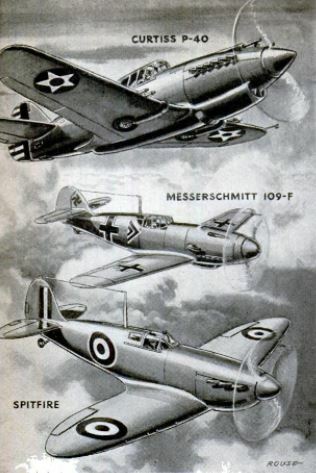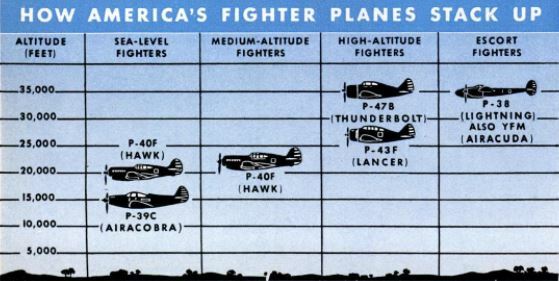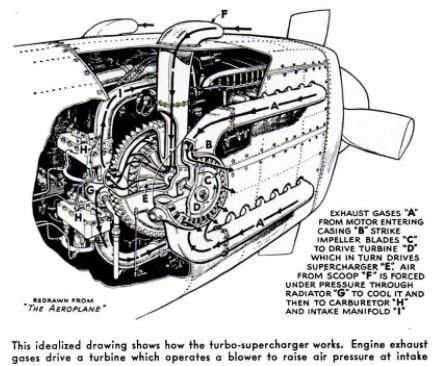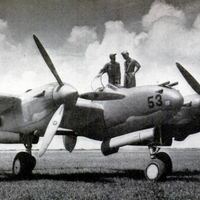-
Title (Dublin Core)
-
U.S. fighter planes overview and comparison
-
Article Title and/or Image Caption (Dublin Core)
-
Title: How America is using her Ships Fighter
-
extracted text (Extract Text)
-
WHERE is a U. S. Army
fighter plane—the Lock-
heed P-38—which, viewed
from a certain angle, looks
like three airplanes instead
of one, until you see that it
consists of a fuselage mount-
ed between two slim engine
nacelles and two sets of tail
surfaces. Here is another-
the Republic P-47B—packing
about the same weight and
wallop as the P-38, but utter-
ly different in size and con-
tour, with a single engine 80
large that it dwarfs the rest
of the plane. And still others,
some of more or less “con-
ventional” design like the
Curtiss P-40's, with the pilot
sitting amidships behind the
engine, or the engine in back
of the pilot as in the Bell
P-30C, or with pusher pro-
pellers like the Bell YFM.
They differ in what can be
seen and more in what can-
not be seen—in armor, fuel
tanks, superchargers, and
auxiliary equipment —and yet
every one of them is a U. S.
Army fighter and nothing
else.
Why should planes In the
sume general category, flown
by the same service, show
such variations in design? One reason is
that development is proceeding at a very
rapid pace, and a lot of good ideas are com-
peting for supremacy. But a more com-
pelling reason is the complexity of the
problems which call for solution. After all,
to say that a plane is designed to fight is
pretty vague. When—by day or by night?
Where—at 30,000 feet altitude or 3,0007
Whom—is it to attack enemy bombers or
protect friendly bombers? When such
questions are asked it becomes evident that
the fighter plane must be designed for one
or two fairly specialized jobs.
When we survey existing models of fight
ers on this basis, a more or less logical
pattern of design and development begins
to emerge. There are three principal types
of fighters on the basis of range. The inter-
ceptor is designed for operations close to its
base. The pursuit plane for night fighting
and extended day operations requires a
considerably longer range, while heavy
fighters for escort duty with bombers cover
still greater distances.
First, the interceptor. The name indicates
what its job is—to get off the ground on the
shortest possible notice, climb with the
greatest possible speed, and scare off or
shoot down bombers, if possible before they
can reach their objective. It is essentially
a flying machine-gun nest—a small, highly
maneuverable plane with a big engine. The
engine must be big to get the plane up
there fast and to give it the advantage
over the bomber in speed—which, nowa-
days, calls for 400 m.p.h. and up.
The interceptor is an inherently limited
type of plane, capable of carrying only a
few guns, no great amount of ammunition,
only enough gas for a few hundred miles
of flight, and one man to do all the work of
piloting ‘and shooting. For the interceptor
pilot the motto is, If at first you don’t suc-
ceed, give up and fly home. He just hasn't
the ammunition or the fuel to do anything
else. And there is no point in sending him
up unless the general locality where he will
‘meet the bomber is pretty definitely known.
For all these reasons the interceptor is es-
sentially a daylight weapon.
But because the interceptor can do deadly
work when the conditions are right, bomb-
ers fly mainly at night. The night pursuit
plane does not need the high maneuvera-
bility and top speed of the day interceptor.
It is not going to engage in a dogfight. On
the other hand, it needs much more gas
capacity, for ordinarily it will take some
time to find the bomber. For this purpose
the night fighter is equipped with some
form of long-range detection device. Even
after the bomber is located and sighted,
considerable stalking time must remain in
the gasoline tanks. When the opportunity
for the kill finally presents itself, the pur-
suit plane must close in and do the job
quickly.
Day interceptors are almost
always single-engine planes.
For a given amount of power
a single-engine plane is more
maneuverable than a two-
engine plane. Night fighters
may have one engine or two.
The multi-engine fighter may
also be advantageously used
in extended day pursuit opera-
tions. It carries considerable
armament in the form of
20-mm. cannon or larger, and
machine guns of .30 and .50
caliber. The crew normally
consists of two men. Such
planes are suitable for patrol
work and long-range hunting,
and also for escorting friendly
bombers.
The design of fighter planes
is conditioned as much by
bomber performance as by
the characteristics of other
fighters. It is the bomber which works
destruction on land and sea, and the ulti-
mate function of the fighter is to down
bombers. The fighter tackles an enemy
fighter to put him out of the way so that
he or someone else can get a whack :t a
hostile bomber or some similar flying ob-
jective.
The way in which bomber design affects
fighter design is: well illustrated by the ap-
plication of superchargers, first to bombers,
then to pursuit planes. A gasoline engine
normally loses power as it gets into the
rarefied atmosphere of the higher altitudes,
where the cylinders gulp in less air for each
piston stroke. This loss can be counter-
acted by increasing the size of the cylinders
—to which there is a limit—or by super-
charging. The original Boeing Flying Fort-
ress had a top speed of 250 m.p.h. at 13,000
feet with its four motors wide open. With
the same motors supercharged, it is good
for more than 300 m.p.h. at 20,000 feet, and
it can cruise comfortably at 245 m.p.h. at
30,000 feet. The same thing must be done
for fighters intended to operate at high alti-
tudes, but it is harder because of limited
space and weight allowances.
With the above considerations in mind we
can discern the general design pattern of
our current Army fighter models. Almost
all the types to be described have proved
their merits in actual combat. Naturally
some are better than others. A few will fall
by the wayside, others will undergo further
development. Later models will be quite
different from their prototypes, and a lot
better.
Typical of the one-engine, one-seat fight-
ers designed for sea-level operation—which
means between sea level and an altitude of
about 20,000 feet—are planes like the Bell
P-39 Airacobra and the Curtiss Hawk line.
The P-39C is powered by a 12-cylinder,
1,150-h.p., liquid-cooled Allison motor which
drives a three-bladed tractor propeller
through a 10-foot extension shaft. Landing
gear is of the tricycle type. The armament
consists of a 20-mm. cannon in the pro-
peller hub, as well as light and heavy-caliber
machine guns. The weight of the plane,
loaded, is 7,380 pounds, this includes suffi-
cient ammunition for fairly sustained fire.
The range at the most economical cruising
speed is 1,100 miles, which is very good. A
plane with these characteristics is more
than a match for the equivalent Messer-
schmitt, the Me-109F, and approximately
equal to the British Spitfire. But only up
to about 16,000 feet.
The later Curtiss Hawks are designed for
somewhat higher ceilings. The current mod-
el stems from the original P-36, through the
P-37 and the more highly streamlined P-40D
and E. The earlier P-40’s compared favor-
ably with the older Spitfires and Hurricanes;
the latest type is believed to equal or excel
any of the European fighters. Increases in
speed and high-altitude performance have
been achieved in spite of greatly increased
armament, ammunition loads, and armor
plate.
U. S. Army fighters specifically designed
for high-altitude operations —between say
16,000 feet and the present effective ceiling
of about 35,000 feet—include the Republic
P-43F Lancer and the same company’s
P-47B Thunderbolt. The P-43F is powered
with a Pratt & Whitney Twin Wasp 1,200-
h.p. air-cooled engine. The loaded weight
is slightly less than that of the Airacobra—
6,900 pounds. Armament consists of large
and small-caliber machine guns. The com-
panion Republic pursuit plane, the P-47B, is
at present the most powerful of American
single-engine, single-seater fighters. The
motor is a 14-cylinder, 2,000-np. Pratt &
Whitney radial, driving a four-blade pro-
peller. High-altitude performance is ob-
tained by means of a turbo-supercharger.
This plane is said to have reached a speed
of 680 m.p.h. in a power dive.
The U. S. Army has two twin-engine
fighters for escort service and special mis-
sions. One is the Lockheed P-38 Lightning
and the other the Bell YFM-1A Airacuda.
Both are armed with cannon and machine
guns. The P-38 is the faster of the two,
while the YFM has much the greater range
—some estimates run as high as 3,000 miles.
The P-38 carries a crew of one or two, the
YFM a crew of five. For high-altitude serv-
ice these heavy fighters are equipped with
turbo-superchargers. Weights of two-en-
gine fighters run around 11,000-14,000
pounds, as compared with 6,000-8,000
pounds for single-engine fighters.
The U. S. Navy uses air-cooled engines
for its carrier-based fighters. Such planes
must be equipped with arresting hooks
which engage horizontal cables on the car-
rier deck to bring the plane to a quick stop
in landing. This calls for stronger and
heavier undercarriages. The wings of some
of the later types fold so that more planes
may be accommodated in a given deck
space. Gasoline capacity is at least 50 per-
cent higher than in land-based planes of the
same type. In spite of these handicaps,
naval fighters are nearly as fast as the
equivalent Army aircraft and the service
ceilings are about the same.
Principal naval fighters are the Brewster
Buffalo (F2A) and Grumman Wildcat
(F4F). The latest model of the latter, the
F4F-3, is a single-place monoplane powered
with a 1,200-h.p. Pratt & Whitney air-cooled
twin-row engine. Its cruising range is about
1,000 miles. Most efficient operation is at
20,000 feet. Normal armament consists of
four 50 caliber machine guns. For light
dive-bombing operations two 11-pound
bombs may be carried. This plane is said
to have been dived at over 500 m.p.h., but
another Navy fighter, the Vought-Sikorsky
Corsair, F4U-1, is even faster. The Navy
also has an experimental two-engine fighter,
the Grumman Skyrocket (XF5F-1).
It is interesting to compare these Ameri-
can fighter planes with European models.
The German Messerschmitt Me-100F is in
the same class as our latest P-39's and
P-40's. It is powered with a 1,150 h.p.
Daimler-Benz DB-601N motor, liquid-cooled
and supercharged for
a 40,000-foot service
ceiling. The speed is
362 m.p.h. at 13,000
feet, and 380 m.p.h.
at 21,000 feet, the
latter being the top
speed. Range is 370
miles at 307 mph.
(1.2 hours), and 600
miles at 262 mph.
(2.3 hours). The
principal novelty of
this fighter is a Mau-
ser 15 or 20-mm.
cannon firing 900
rounds per minute—
just below the nor-
mal rate of fire of a
modern machine gun.
Loaded, the plane
weighs 6,000 pounds.
It is said to have
been especially de-
signed for dogfights
and admittedly has
a faster climb than
the British Spitfire, but the latter has shown
better maneuverability in encounters.
The British Beaufighter I is a two-engine,
two-place fighter adapted from a medium
bomber. Each engine is rated at 1,400 h.p.
The armament is very heavy—four fixed
cannon in the fuselage and six fixed ma-
chine guns in the wings. The maximum
speed is fair—330 m.p.h., and the service
ceiling is 20,000 feet. The opposing Ger-
man fighter, the twin-engine Me-110, has a
higher top speed—365 m.p.h. Another Ger-
man twin-engine fighter, the Focke-Wulf
FW187, with about the same maximum
speed (at 20,000 feet) is said to have a
service ceiling of 39,000 feet. Equivalent
American two-engine fighters like the Lock-
heed P-38 are believed to be superior in
speed, climb, and hitting power.
The designer of a modern fighter plane
strives for maximum speed, power and alti-
tude performance, maneuverability, fire
power, and armor protection. Speed, to pre-
vent the enemy fighter or bomber from es-
caping by diving or straight flight. Power,
to prevent the enemy from escaping by
zooming, and maneuverability so that he
cannot elude his pursuer by a sudden change
in direction. Fire power is vital so that
the enemy may be put out of commission
in the few seconds of close engagement.
Since the enemy has exactly the same pur-
pose, the best possible armor protection
must be provided.
Almost all the basic factors—speed, pow-
er, altitude performance, weight, etc. are
tending to rise. Speeds are or will soon be
between 400 and 450 m.p.h. at altitudes be-
tween 20,000 and 85,000 feet. This means
that the airplane must be as small as pos-
sible to reduce drag. Weights, nevertheless,
are increasing because of ordnance, armor-
protection, and engine requirements.
Supercharging is essential for efficient op-
eration at high altitudes. Two general types
of superchargers are at present available—
centrifugal blowers or compressors gear-
driven by the engine, and turbo-supercharg-
ers which utilize the exhaust gases to drive
a turbine wheel which in turn drives the
compressor. The geared superchargers are
simpler, but they work well only at the
middle altitudes.
The propeller presents a similar problem.
A propeller which may be satisfactory at
sea level and under take-off conditions will
have entirely unsatisfactory propulsive efi-
ciency at high altitudes and high speeds. A
propeller suitable for a medium-powered
engine will not work with a larger engine.
The propeller tip speed can be increased
only to a given point, and of course the
diameter is limited by structural considera-
tions. Consequently the tendency is toward
a greater number of blades.
Modern propellers for high-altitude flight
must be equipped with pitch control. Be-
tween take-off and terminal-velocity dive
the pitch range may have to be as high as
40 degrees. The pilot cannot attend to it;
he has too many other things to do. Auto-
matic pitch-control devices are mandatory.
Protection and fire power seesaw in the
air as in battleship design. Bigger guns
call for thicker armor, thicker armor calls
for bigger guns, but guns and ammunition
add weight and cut down speed. Again the
solution is by compromise—the continued
installation of both .30 and 50 caliber ma-
chine guns on fighters is one example. At
first 30 guns were adequate. Heavier ar-
moring brought .50 guns and cannon.
Small cannon are valuable when the pur-
suit plane tackles a bomber. Aerial en-
gagements with machine guns must be
fought at close quarters, usually not ex-
ceeding 300 meters. On the other hand, a
pursuit plane armed with a cannon can
damage a bomber and sometimes bring it
down, without coming within the effective
fire area of the bombers machine guns.
Radical developments in future fighter
designs are possible, even probable. Per-
haps the most rapid progress may be ex-
pected in night fighting and in what may
be called engineering the pilot for combat
at high altitudes. In wartime these and
other matters are best left to the imagina-
tion. The enemy will find out about them in
due course, but he will have to get the in-
formation in the air, and, we may hope, at
a high cost.
-
Contributor (Dublin Core)
-
Carl Dreher (Article Writer)
-
Language (Dublin Core)
-
eng
-
Date Issued (Dublin Core)
-
1942-04
-
pages (Bibliographic Ontology)
-
52-59
-
Rights (Dublin Core)
-
Public Domain (Google Digitized)
-
Archived by (Dublin Core)
-
Roberto Meneghetti
-
Marco Bortolami (editor)
 Popular Science Monthly, v. 140, n. 4, 1942
Popular Science Monthly, v. 140, n. 4, 1942








